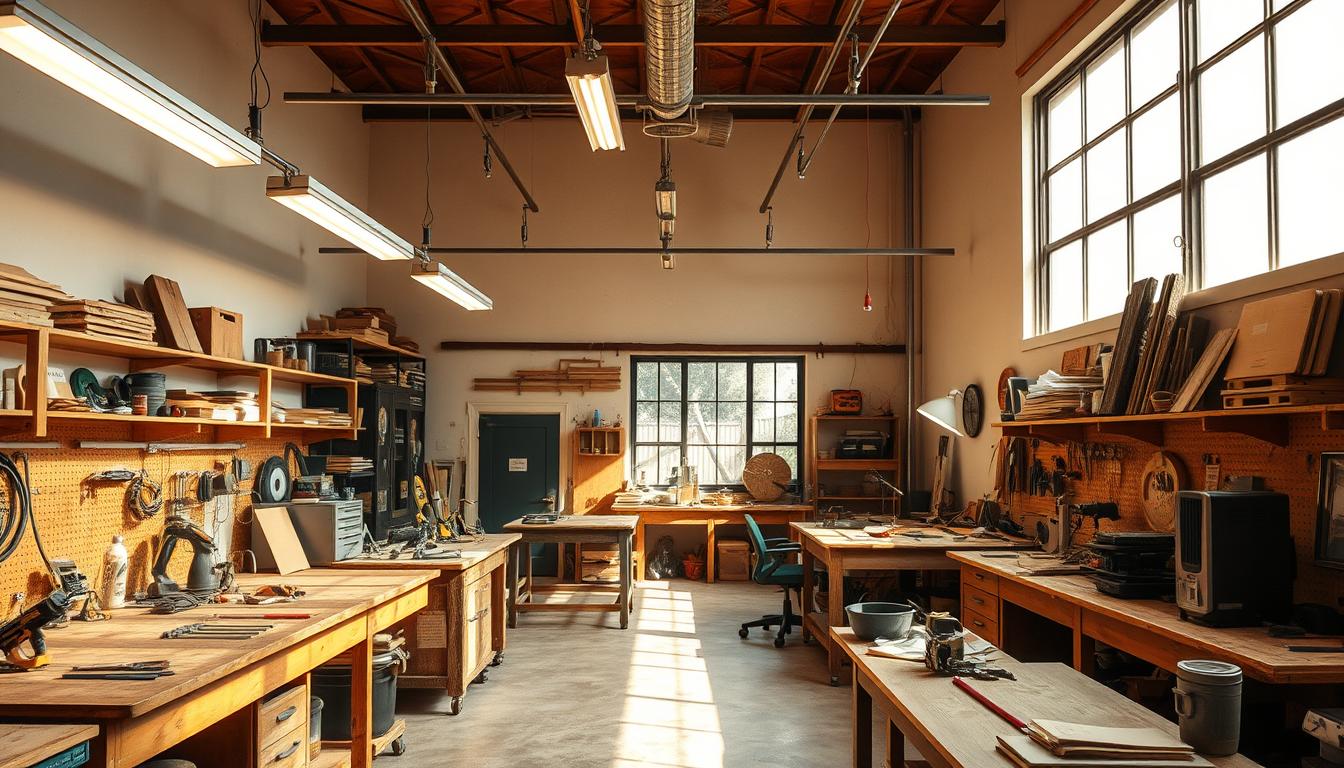Good workshop lighting is key for any project. It makes things visible, safe, and boosts productivity. The right lighting helps you work better, without distractions.
Lighting in your workshop is crucial for safety and accuracy. It makes your work area better, helping you do your best. Whether it’s a small task or a big project, good lighting is essential.
Key Takeaways
- Proper workshop lighting enhances visibility, safety, and productivity
- Effective workspace illumination is crucial for achieving clear vision in every project
- Workshop lighting reduces the risk of accidents and errors
- Investing in proper workshop lighting improves the overall work experience
- Adequate workspace illumination is vital for success in any project
- Workshop lighting is essential for creating a comfortable and efficient working environment
The Essential Role of Workshop Lighting in Workspace Safety
Good lighting is key to a safe work area. A well-thought-out lighting plan can cut down on accidents and injuries. It helps workers do their jobs better and with less chance of mistakes.
Right lighting also stops eye strain and tiredness, common in poorly lit workshops. This makes workers more productive and happy. Plus, it keeps the area safe from slips and falls, making it safer for everyone.
Impact on Worker Productivity
Good lighting boosts worker productivity a lot. It lets workers focus without eye strain, making them more efficient and accurate. This leads to better work and fewer mistakes, helping the whole company.
Preventing Eye Strain and Accidents
To avoid eye strain and accidents, a smart lighting plan is needed. This includes overhead, task, and emergency lights to light up all parts of the workshop. This way, workers can work safely and well, lowering the chance of accidents.
Meeting Safety Standards and Regulations
Lastly, good lighting helps meet safety rules and standards. It shows a company’s dedication to safety and lowers the risk of accidents. This can save money on fines and make the workplace safer and more positive.
| Lighting Type | Purpose | Benefits |
|---|---|---|
| Overhead Lighting | General illumination | Reduces eye strain, improves visibility |
| Task Lighting | Localized illumination | Improves accuracy, reduces errors |
| Emergency Lighting | Backup illumination | Ensures safety during power outages |
Understanding Different Types of Workshop Lighting
Workshop lighting comes in several types, like task, ambient, and natural lighting. Each has its own benefits and can be mixed to light a space well. Task lighting shines on specific areas, perfect for detailed work like woodworking.
For safety and work efficiency, workspace illumination is key. Ambient lighting makes a space feel cozy and inviting. Natural light is a great, yet sometimes unreliable, option. Knowing about these lighting types helps you light your workspace right.
Task lighting has many advantages:
- It makes things clearer and more accurate.
- It cuts down on eye strain and tired eyes.
- It boosts work speed and quality.
Ambient lighting is also vital for a comfy and safe work area. Mixing these lights creates a space that’s both well-lit and functional for your needs.
To light a workshop well, you need to know about the different lights. Think about task, ambient, and natural lighting. This way, you can make a space that’s safe, comfy, and supports your work.
| Type of Lighting | Benefits | Characteristics |
|---|---|---|
| Task Lighting | Improved visibility and accuracy, reduced eye strain and fatigue | Focused light, high intensity |
| Ambient Lighting | Comfortable and welcoming atmosphere, overall illumination | Soft light, low intensity |
| Natural Lighting | Cost-effective and energy-efficient, natural sunlight | Variable intensity, dependent on time of day and weather |
Strategic Workshop Lighting Placement for Maximum Efficiency
Lighting placement is key in a workshop. It affects efficiency and safety. To get the most out of your space, place lights strategically. This reduces shadows and dark spots, making your workshop safer and more productive.
When placing lights, think about your workshop’s layout and tasks. Overhead lights offer general illumination. Task-specific lights focus on areas like workbenches. This way, you manage shadows and create a safer, more efficient space.
Techniques for Optimizing Lighting Layout
- Assess the workshop’s layout and identify areas that require targeted lighting
- Use a combination of overhead and task-specific lighting to create a layered lighting effect
- Consider the color temperature and intensity of lighting fixtures to ensure they meet the specific needs of the workshop
By using these techniques, workshop owners can make their space well-lit and efficient. This boosts productivity and safety. It also leads to happier workers and fewer mistakes, making your workshop more successful and profitable.
Choosing the Right Brightness Levels for Your Space
When it comes to workshop lighting, brightness levels are key for a comfy and safe space. Different tasks need different light levels. For example, woodworking or metalworking needs bright light to avoid eye strain and improve sight.
A comfy work area boosts productivity and worker happiness. The right brightness levels can cut down eye strain and make workers feel better. Here are some tips for picking the right brightness levels for your workshop:
- Task requirements: Different tasks need different light levels. For example, tasks that need precision work need brighter light than tasks that just need general light.
- Workshop layout: Your workshop’s layout affects the light needed. For example, areas with high ceilings or big windows might need less bright light than areas with low ceilings or little natural light.
- Lighting fixtures: The type and quality of lights matter too. For example, LED lights can give off more bright light than old incandescent lights.
By thinking about these points and picking the right brightness levels for your workshop, you can make a comfy and safe place to work. This will help boost productivity and make workers happier.
Professional Workshop Lighting Installation Guide
Lighting installation is all about electrical safety. A good lighting plan can greatly improve a workshop’s look and function. It’s important to think about the electrical needs and safety first.
Choosing the right lights and how to mount them is key. You should pick between LED or fluorescent lights. Make sure they are securely attached to the ceiling or walls. Proper mounting helps avoid accidents and ensures the lights work right.
Electrical Requirements and Safety Considerations
Before you start, check the workshop’s electrical setup. Look at the power supply, wiring, and circuit breakers.
Important safety tips include:
- Make sure all electrical parts are safe and certified
- Wear gloves and safety glasses when working with electricity
- Use the right wiring and connections to avoid shocks
Wiring and Connection Basics
Correct wiring and connections are crucial for a safe setup. Use the right wire gauge and make sure all connections are tight. Test the system before using it. By following these steps, you can create a well-lit and safe workspace.
| Lighting Type | Electrical Requirements | Safety Considerations |
|---|---|---|
| LED Lights | Low voltage, energy-efficient | Heat dissipation, electrical shock prevention |
| Fluorescent Lights | Higher voltage, more energy consumption | UV radiation, electrical shock prevention |
Energy-Efficient Options for Sustainable Workshop Illumination
Energy efficiency is key in workshop lighting to cut costs and protect the environment. LED solutions are a top choice because they use less energy and cost less to maintain. This makes for a greener and more affordable lighting setup.
Some of the key benefits of energy-efficient lighting include:
- Reduced energy consumption: Energy-efficient lighting solutions, such as LED solutions, use significantly less energy than traditional lighting options.
- Lower maintenance costs: Energy-efficient lighting solutions have a longer lifespan and require less maintenance, reducing the need for frequent replacements and repairs.
- Cost savings: Energy-efficient lighting solutions can help workshop owners save money on their energy bills and reduce their overall lighting costs.
Other options include smart control systems. These let owners control their lighting from afar. They help save energy and cut down on waste.
Choosing energy-efficient lighting is a smart move for workshops. It saves money and helps the planet. With the right choices, workshops can be well-lit and eco-friendly.
| Lighting Option | Energy Consumption | Maintenance Costs |
|---|---|---|
| LED Solutions | Low | Low |
| Traditional Lighting | High | High |
Maintenance and Upgrades for Workshop Lighting Systems
Regular lighting maintenance is key to keeping workshop lighting systems working well. This means cleaning lights, swapping out bulbs, and checking for damage. Doing these things helps avoid accidents, cuts down on energy use, and makes lights last longer.
Also, system upgrades can be a good idea. Switching to energy-saving lights, like LEDs, can lower costs and help the planet. It’s also smart to rethink the lighting setup in your workshop. Make changes to make sure the lighting is right and works well.
Here are some tips for keeping your workshop lights in top shape:
- Make a plan for when to do maintenance tasks
- Choose energy-saving lights
- Get advice from a lighting expert on the best setup for your workshop
By following these tips and focusing on lighting maintenance and system upgrades, you can make your workshop safer, more efficient, and better for work.
Common Workshop Lighting Mistakes to Avoid
Setting up workshop lighting can be tricky. Lighting mistakes can cause poor visibility, eye strain, and lower productivity. One big mistake is not having good color rendering. This makes it hard to tell different colors and materials apart.
To steer clear of these errors, think about what your workshop needs. For example, if you work with small parts, you’ll need lighting with high color rendering. This ensures you can see the details well. But, if you handle big equipment, you might need lighting that covers more area.
- Poor distribution patterns, which can lead to hot spots and dark areas
- Inadequate color rendering, which can make it difficult to distinguish between different colors and materials
- Overlooking natural light integration, which can lead to an overreliance on artificial lighting
Knowing these common lighting mistakes helps you create a better workshop. Make sure your lighting has good color rendering and covers the area well. This way, your workshop will be well-lit and productive.
Specialized Lighting Solutions for Different Workshop Types
Each workshop type has its own lighting needs. For example, woodworking needs lights that highlight small details. Automotive workshops require lights strong enough for heavy machinery.
Here are some common workshop types and their lighting needs:
- Woodworking: high-intensity lighting for detail work
- Automotive: durable lighting that can withstand heavy use
- Art studios: flexible lighting that can be adjusted for different projects
A good specialized lighting system boosts workshop productivity and safety. By matching lighting to each workshop type, owners can make their space more efficient and effective.
Investing in specialized lighting solutions helps workshop owners tailor their space. This leads to better results and success.
| Workshop Type | Lighting Requirements |
|---|---|
| Woodworking | High-intensity lighting for detail work |
| Automotive | Durable lighting that can withstand heavy use |
| Art studios | Flexible lighting that can be adjusted for different projects |
Conclusion: Illuminating Your Path to Workshop Success
Proper workshop lighting is key to safety, productivity, and success. Understanding different lighting types, placing fixtures right, and keeping systems efficient helps. This makes workshops well-lit and productive for everyone.
Whether setting up a new workshop or improving an old one, this guide helps. It shows how to achieve workshop success with the right lighting solutions. You’ll avoid mistakes and make a safe, beautiful workspace that meets your needs.
Workshop lighting keeps getting better with new tech and methods. Stay open to new ideas and keep improving. With the right approach, your workshop will be a place of productivity and success.


